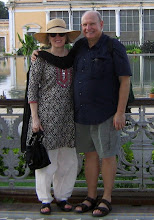
We’ve recently visited two of the “must see” places in Hyderabad. One was the Golconda fort and the other was the Chowmahalla Palace. Fortunately we saw them in chronological order rather than alphabetical which helped put the two places into historical perspective. However, in the news recently, we have to talk about hysterical perspectives as the verdict just handed down in a legal case that is 60 years old is creating tensions between the Hindu and Muslim communities. Our two visits put the reasons why Hyderabad was an important center for the Persians, Moguls, and British over the last 1400 years. Yep, the Persians were here in the seventh century bringing trade and Islam to the area from the west. You also read in an earlier posting that it was purported that St. Thomas, yep, that “show me” disciple of Jesus, came to Chennai to first bring Christianity to India. He was martyred for that. Now pulling in
 the Mamallapuram which was flourishing during the seventh century, you can start to see the volatile political dynamics that we painfully see today.
the Mamallapuram which was flourishing during the seventh century, you can start to see the volatile political dynamics that we painfully see today.The Persian rulers were the occupants of the Golconda (shepherd’s hill).
They were drawn here by the abundance of precious metals and diamonds. From the 14th century to the 16th century, five generation
 s of rulers spent time in the fort complex, building it into a sprawling community surrounded by a medieval wall. The Moguls in the north saw Hyderabad as a prize worth the effort and in the 16th century, set siege to the fort after the Nizam would not negotiate. Net: Moguls win, Persians lose, fort is abandon until the British set up their operations in the Hyderabad area after the Mutiny of 1848-1849 with the largest garrison of troops anywhere in India. Funny, the for
s of rulers spent time in the fort complex, building it into a sprawling community surrounded by a medieval wall. The Moguls in the north saw Hyderabad as a prize worth the effort and in the 16th century, set siege to the fort after the Nizam would not negotiate. Net: Moguls win, Persians lose, fort is abandon until the British set up their operations in the Hyderabad area after the Mutiny of 1848-1849 with the largest garrison of troops anywhere in India. Funny, the for t history doesn’t seem to mention the British occupation. Of course, when I first went on the Hyderabad website, there was a gap between the mid-19th century until 1947. Seems like everyone went on vacation and didn’t keep a diary. In the vista picture looking from the fort, you can actually see our apartment building on top of the distant hill and four buildings to the left of the radio tower.
t history doesn’t seem to mention the British occupation. Of course, when I first went on the Hyderabad website, there was a gap between the mid-19th century until 1947. Seems like everyone went on vacation and didn’t keep a diary. In the vista picture looking from the fort, you can actually see our apartment building on top of the distant hill and four buildings to the left of the radio tower.Now after the Moguls established themselves as the rulers and did make nice with the British, the new Nizams took advantage of the wealth that was available in the area. In the later part of the 19th century, they began to construct the Chowmahalla Palace which was the seat of the last four Nizams. I believe Chowmahalla is a Mogul term for “It’s great to be King”. But you’ll have to judge for yourselves: Medieval fort or opulent palace. Pick one.
 Even when she is in traditional "native" dress, Deb sticks out like, well, you know. But we climbed all seven-hundred-twenty-eight steps to the top of the fort. It is a massive complex with sections built at various times throughout the nearly 400 years of its occupation.
Even when she is in traditional "native" dress, Deb sticks out like, well, you know. But we climbed all seven-hundred-twenty-eight steps to the top of the fort. It is a massive complex with sections built at various times throughout the nearly 400 years of its occupation.
Just like the issues dealing with the 60 year old legal case where a mosque was built on the site of a former Hindu temple and, sparing you all the details, the two groups claimed their right to the site. Interestingly, in the fort, constructed by the Persian Nizam, there is a Hindu temple with a structure outside it that looks like something you'd see on the third floor of MOMA. The contrast of its verticality with the litter that gets caught in the structure gives it that gritty modernity that comes alive and vibrantly represents the lingering tension of deeply held feelings of the ethnic religiosity versus the power structure based on a credo belief. Oh, sorry, I was channelling a docent we saw at the Whitney who was explaining a Jasper Johns' work to a group of Japanese tourists.
 Now, the Chowmahalla palace belonged to the Mogul Nizams who, up till 1960, lived in the opulence that could only have been enjoyed by playing nicely with the British during the Raj.
Now, the Chowmahalla palace belonged to the Mogul Nizams who, up till 1960, lived in the opulence that could only have been enjoyed by playing nicely with the British during the Raj.



 But of all the grandeur and opulence, the one thing that just stuck with me was one below which just summarizes the way things work here in Hyderabad.
But of all the grandeur and opulence, the one thing that just stuck with me was one below which just summarizes the way things work here in Hyderabad.


No comments:
Post a Comment